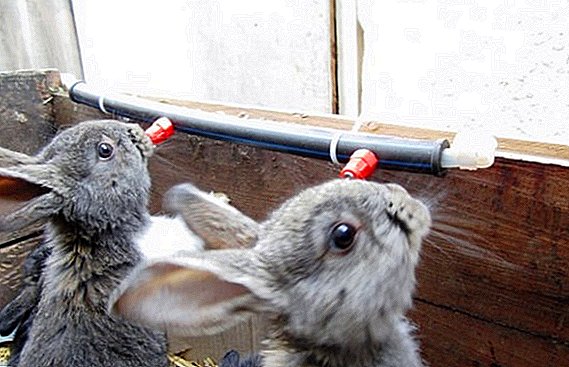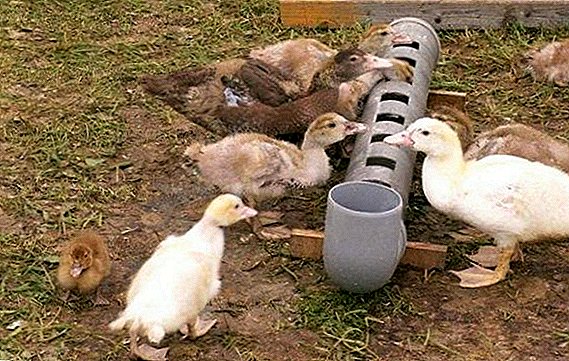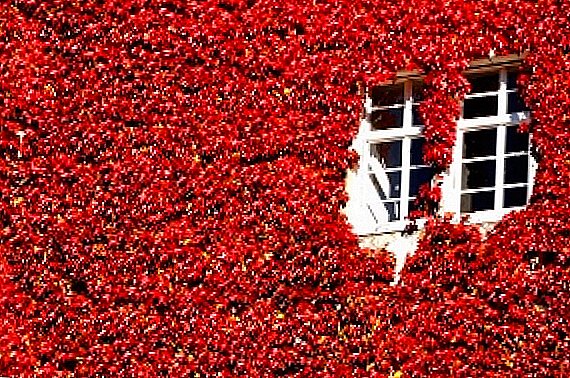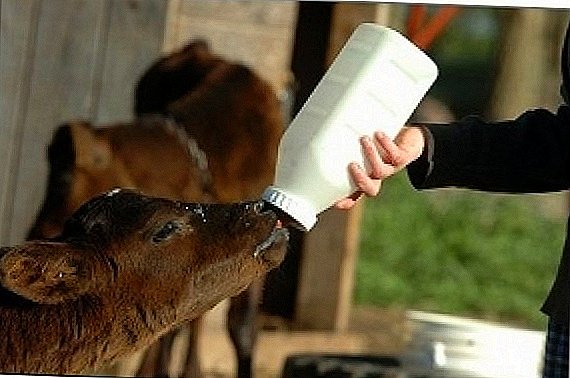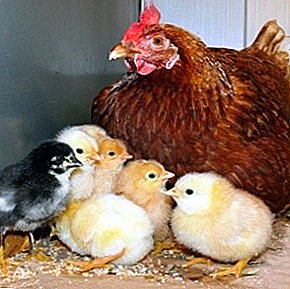
On private farmsteads often used natural method of breeding chickens.
He does not require increased attention from the breeder, as the hen hen regulates the temperature of the eggs independently. However, this breeding method is suitable only for those breeds of chickens that have a well-developed maternal instinct.
Now there are a large number of breeds of chickens that have completely lost their maternal instinct. Their reproduction becomes almost impossible, so breeders buy incubators.
Fortunately, many meat and egg breeds have this instinct well preserved, so private farmers can breed chickens in the old proven way - with the help of hens.
Hatch under the hen
For the role of hen are perfect calm hens. Such birds rarely actively run around the yard and do not try to fly up to the fences. Most of the time they spend in the house, sitting in a nest.
On top of that, the hen should not be too large, since heavy birds can accidentally crush the thin egg shell.
A farmer can get ahead that the hen is about to form a clutch according to her unusual behavior. A hen chooses a nest for himself in the most quiet corner of the house. She carries there dry stalks of grass, fallen leaves, as well as fluff.
Gradually, she begins to lay eggs, which diligently incubates until the chicks appear. As a rule, such a bird cannot be driven away from the nest, since it will still return there to continue the process.
How to prepare chicken for brooding?
 Usually, domestic chickens show a desire to lay eggs in March and April. It is at this time of year that it is best to start growing chickens.
Usually, domestic chickens show a desire to lay eggs in March and April. It is at this time of year that it is best to start growing chickens.
After the hen hen has been determined, it is necessary to plant it on the linings for two or three days. This will help the farmer to know if the chicken will hatch the eggs to the end.
Bad hens do not withstand such a period, so they cease to follow the laying.
Good hens immediately begin to hatch liners. They also line their nest with fluff so that the eggs do not cool when the chicken goes in search of food.
When a person appears, they do not rise from the nest, but begin to quietly cluck. If the chicken has all these signs recorded, then we can assume that it is ready for patient chickens to incubate.
Nest placement and arrangement
 For more efficient hatching under the hen you need to take care of reliable nests.
For more efficient hatching under the hen you need to take care of reliable nests.
They can be made in the form of wooden boxes and wicker baskets lying on the floor or hung on the walls of the house. Whatever the nest, and the hen needs to be able to safely accommodate it.
The exit from the floor nest is always curtained with a small mat made of straw. In no case should it prevent the hen from entering and leaving the nest.
A 7-centimeter layer of sod or dry earth covered with straw is poured on its floor. Particular attention should be paid to the corners of the nest.
Sometimes eggs can roll out from the middle of the nest to its walls.. To avoid this, it is enough to make a convenient dimple in the middle.
It is usually covered with soft straw or hay. You can also put a certain amount of fluff.
All nests with hens should be located in quiet corners, where a person cannot penetrate. This makes it possible to reduce the stress of a bird that may be frightened by a person.
 The chickens of a chickens: the cultivation, especially the content and subtleties of care. All this you can find on our website.
The chickens of a chickens: the cultivation, especially the content and subtleties of care. All this you can find on our website.And about the content of laying hens is detailed here: //selo.guru/ptitsa/kury/vyrashhivanie/soderzhat-nesushek.html.
If there are several hens in one hen house, then the nests should be carefully fenced from each other. Thus, each hen will hatch its laying, and the risk of a fight will be reduced to zero.
What kind of eggs fit?
 After checking the maternal instinct of the chicken with the help of liners, you can think about the selection of real chicken eggs.
After checking the maternal instinct of the chicken with the help of liners, you can think about the selection of real chicken eggs.
Before lining, they should be inspected for cracks, grooves and any other shape changes. Too small and too large eggs are rejected immediately.
A farmer needs to remember that a good hen can sit only the number of eggs that can fit freely in her body. It usually ranges from 13 to 15 pieces. Also under the chicken you can lay eggs of other poultry, for example, ducks and geese.
Bird care
 The number of chicks raised depends largely on the care of the hen during hatching.
The number of chicks raised depends largely on the care of the hen during hatching.
During this period, it should leave the nest 1-2 times. Usually the bird goes to eat or drink water. If she herself does not want to leave the nest, then she is taken in her arms and carried to the courtyard.
In this way, the exhaustion of the mother hen during the incubation of the eggs is prevented. It is enough for her to stay in the fresh air for 20 minutes, after which she can return to the nest.
Sometimes there are times that the chicken doesn't want to sit on the eggs again. In such a situation, it is best to force the bird to sit in the nest again. To do this, it must be caught and seated on laying eggs.
Some hens are afraid to move far from the nest, as they worry about the state of the eggs. Because of this, some private breeders equip drinkers and feeders in close proximity to the nest.
Also near the set box with ash. In it, the bird will take "sand" baths, allowing to get rid of parasites.
Control of embryo development
 During natural hatching of chickens, it is important to control the development of embryos in the eggs on which the hen sits. All examinations are carried out with the help of an ovoscope.
During natural hatching of chickens, it is important to control the development of embryos in the eggs on which the hen sits. All examinations are carried out with the help of an ovoscope.
The first occurs on day 6 of incubation. During this period, the embryo is still too small, so it is not very noticeable during translucence. However, blood vessels in the yolk sac are clearly visible.
If the embryo develops poorly, then the vessels have a darker shade.. Unfertilized eggs on a gleam look empty. So that the bird does not incubate empty eggs, they are removed from the nest.
The second inspection of the masonry takes place on the 10th day of incubation. All embryos are clearly visible during this period, the network of blood vessels is also noticeable.
The third inspection of masonry takes place on the 18th day of brooding. With the help of an ovoskop, a farmer can see that the embryo is very large and even moves a little.
The appearance of young
 This period is the most responsible in the natural rearing of chickens.
This period is the most responsible in the natural rearing of chickens.
Immediately it should be noted that the timing of laying eggs may not coincide with the tabular data that exists in each individual breed.
They are completely dependent on storage conditions, as well as on the quality of brooding. Therefore, before removing the hen from the nest, you need to check all the eggs for viable embryos.
Sometimes during the hatching period, chicks need help getting out of the egg.. For this, the shell is carefully cracked, and the chicken's head is gradually freed.
However, in no case should chicks be taken away immediately from the hen. They must be dried, and only after that they can be removed.
All removed chicks are gently pulled from under the hen and placed in a wooden box filled with straw. It is placed in a warm and dry place so that the chickens can warm up well.
On top of the box with chickens closes with gauze. The next evening, chicks can be planted in the hen. As a rule, one chicken can “drive” from 20 to 25 chickens.
Conclusion
Natural hatching is the easiest way to breed chickens. At its use the minimum money is spent. It is enough to choose a good chicken hen, prepare it and choose good eggs from which healthy chickens can hatch.


